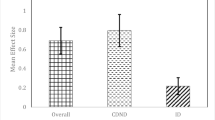Abstract
This study examines results of a practical drawing task given to a cohort of first year dental surgery students at Kings College Dental Institute, London. It compares and relates their success in drilling and removing caries and pulp tissue from a virtual tooth using the hapTEL virtual learning system, with each individuals’ drawing skills. Evidence of particular skills was further analysed using drawing criteria focussed on five key areas, related particularly to how the students recorded the structure and tactile nature of a three dimensional object using conventional and non conventional drawing materials.







Similar content being viewed by others
References
Giachritsis, C., L’anson, S., & Prytherch, D. (2011). Haptic discrimination of different types of pencils during writing. Ergonomics, 54(8), 684–689. doi:10.1080/00140139.2011.595511.
Grunwald, M. (Ed.). (2008). Human haptic perception; basics and applications Basel (pp. 165–182). Basel: Birkhauser Verlag.
Paterson, M. (2007). The Senses of touch: haptics. Oxford, Berg: Affects and Technologies.
San Diego, J. P., Cox, M. J., Quinn, B., Newton, J. T., Banerjee, A., & Woolford, M. (2012). Researching haptics in higher education: The complexity of developing haptics virtual learning systems and evaluating its impact on students’ learning. Journal Computers Education Archive, 59(1), 156–166.
Tversky B (2011) Visualizing thought, topics in cognitive Science 3 (2011) 499–535 http://mindmodeling.org/cogsci2013/papers/0138/paper0138.pdf. Accessed Feb 2014.
Tversky, B., & Suwa, M. (2009). Thinking with sketches. In A. Markman (Ed.), Tools for innovation. Oxford: Oxford University Press. http://wwwpsych.stanford.edu/~bt/diagrams/papers/9780195381634_0075-0084_Markman_TOFI_Ch04.pdf. Accessed Feb 2014.
Tversky, B., Zacks, J. M., & Martin Hard, B. (2008). The Structure of Experience. In T. F. Shipley & J. M. Zacks (Eds.), Understanding events: from perception to action (pp. 436–466). New York: Oxford University Press.
Wulf, G., Shea, C., & Lewthwaite, R. (2010). Motor skill learning and performance: a review of influential factors. Medical Education, 44, 75–84. doi:10.1111/j.1365-2923.2009.03421.x.
Author information
Authors and Affiliations
Corresponding author
Additional information
HapTEL is a system using Haptic Technology Enhanced Learning.
Rights and permissions
About this article
Cite this article
Wright, J. Drawing Links Within Dental Education. Tech Know Learn 22, 173–184 (2017). https://doi.org/10.1007/s10758-016-9295-7
Published:
Issue Date:
DOI: https://doi.org/10.1007/s10758-016-9295-7




